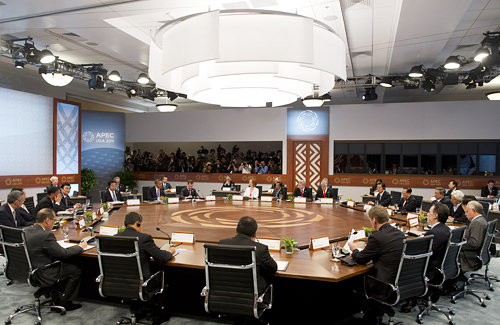|
 |
|
AT THE TABLE: APEC leaders at their 19th summit in Honolulu, Hawaii on November 13 (ZHANG JUN) |
Barack Obama has been an active free trade promoter in recent months. The U.S. president signed free trade agreements with South Korea, Colombia and Panama in October. He then brought a new trade deal to the Asia-Pacific region. When hosting the APEC Summit in Honolulu, Hawaii in November, he put the Trans-Pacific Partnership (TPP), a previously little-known cause, at the top of his agenda.
The TPP is a multilateral free trade agreement originally signed in June 2005 by Brunei, Chile, New Zealand and Singapore. Over the past years, Australia, Malaysia, Peru, the United States and Viet Nam have also been negotiating to join the group.
As one of the numerous trade arrangements in the burgeoning Asia-Pacific region, the TPP could play a positive role, analysts said. But it should address the concerns of all regional players instead of imposing high standards in disregard of the region's huge economic diversity.
Leaders of the nine nations have agreed on the "broad outlines" of the TPP agreement, Obama said at the APEC Summit on November 12.
"There are still plenty of details to work out, but we are confident that we can do so. So we've directed our teams to finalize this agreement in the coming year," Obama said.
The proposed trade pact's details mostly remain confidential, but countries will agree to a single schedule of tariff reduction and common regulations for seamless business operations across borders. The trade deal will cover areas traditionally included in trade agreements as well as services, intellectual property, investment and state-owned enterprises, and could bring most import tariffs on trade within the group to zero over a 10-year period after the negotiations are completed.
According to the Singapore Institute of International Affairs (SIIA), the nine countries currently engaged in TPP negotiations aimed to reach a final agreement by July 2012. "The July date also means the TPP might be signed before Obama faces the U.S. presidential elections, giving him a boost as he seeks a second term," said an article posted on the research institute's website.
Analysts said the U.S.-led TPP agreement will reaffirm U.S. engagement with Asia. By finalizing this trade deal, Obama "seeks to cement the United States' economic role in Asia," said Bernard Gordon, a professor of political science with the University of New Hampshire, in his recent article published in Foreign Affairs.
Japanese Prime Minister Yoshihiko Noda announced Japan was joining TPP negotiations on November 11, a widely anticipated statement that observers argued would elevate the importance of the pact.
With Japan, the world's third largest economy, on board, the size of that free market zone will be widened substantially. The eight TPP partners account for less than 6 percent of U.S. trade, about the same amount as U.S. trade with Japan alone. A combination of the economic clout of the United States and Japan might attract others to join the club.
But Japan's accession to the TPP depends on its ability to reform and open its agriculture sector. And there are skepticism and opposition in Japan regarding the merits of the trade pact. Japan needs to overcome these hurdles before becoming a TPP member.
Canada and Mexico also expressed their interest in joining the TPP as the APEC Summit wrapped up.
China, the world's second largest economy next to the United States, has yet to announce any intention to join TPP talks.
Pang Sen, Deputy Director General of the Department of International Organizations and Conferences at the Chinese Foreign Ministry, said at a news conference after the APEC Summit that China will "earnestly study" the TPP. China has "an open attitude to all mechanisms that are beneficial to promoting economic integration in the Asia-Pacific region," Pang said, adding that such mechanisms should be "open, transparent and inclusive" to make a difference.
China has earlier said it supports free trade in the Asia-Pacific region and will watch the progress of the TPP. It has also indicated the thresholds for the TPP are too high for some developing countries, including China.
Though the United States has touted the TPP as a "21st-century agreement" that will lead to flourishing regional trade, its real economic effects remain uncertain.
"We still need to analyze whether or not it is in line with the interests of most countries in this region as well as its impact on the world economy," said Song Yinghui, a researcher with the China Institutes of Contemporary International Relations. Whether China should join the group will depend on a comprehensive analysis of the TPP's overall impacts, Song added.
| 